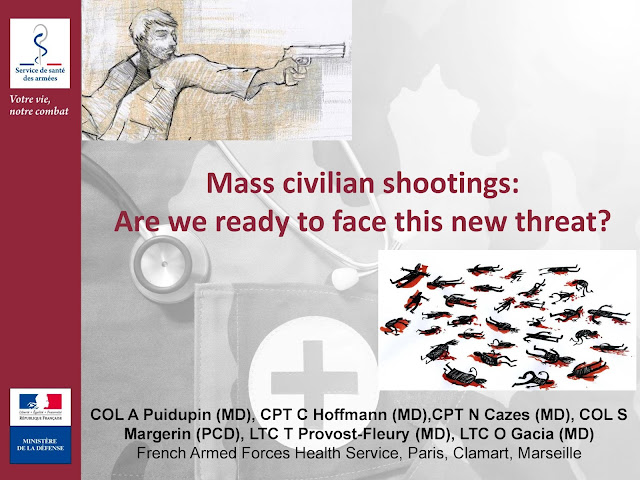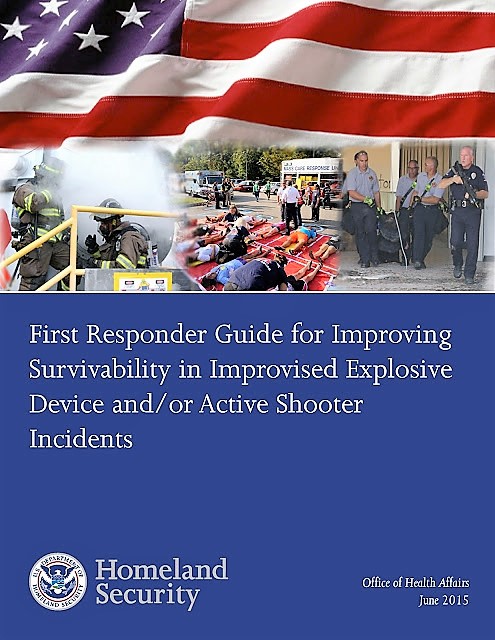 |
| Mass civilian shootings: Are we ready to face this new threat? |
COL A Puidupin (MD), CPT C Hoffmann (MD),CPT N Cazes (MD), COL S Margerin (PCD), LTC T Provost-Fleury (MD), LTC O Gacia (MD) French Armed Forces Health Service, Paris, Clamart, Marseille
Link to download a free PDF document
Related
 |
The Hartford Consensus III Compendium, September 2015. PHTLS B-Con Bleeding Control for the Injured Course "Stop The Bleed" / Control de Sangrados para el Herido By NAEMT.
 |
The Committee for Tactical Emergency Casualty Care used the military battlefield guidelines of Tactical Combat Casualty Care (TCCC) as an evidenced based starting point in the development of civilian specific medical guidelines for high threat operations. Each phase and medical recommendation of the military TCCC guidelines was examined and discussed by the Committee, and then was re-written, annotated, or removed through consensus voting of the Guidelines Committee to create civilian specific, civilian appropriate guidance. Additionally, the Committee added and/or put specific emphasis on several medical recommendations not included in TCCC to address high threat operational aspects unique to civilian operations.
The first phase of care under TCCC is Care Under Fire (CUF). To meet the various operational scenarios and terminology utilized in the civilian sector, the first phase of care under TECC was renamed “Direct Threat Care (DTC).” The priorities of DTC remain relatively unchanged from CUF; emphasis remains on mitigating the threat, moving the wounded to cover or an area of relative safety, and managing massive hemorrhage utilizing tourniquets. Additionally, emphasis was placed on the importance of various rescue and patient movement techniques, as well as rapid positional airway management if operationally feasible. Treatment and operational requirements are the same for all levels of providers during this phase of care. The second phase of care under TCCC is Tactical Field Care. For the same reasons listed above, this phase was renamed in TECC to be called “Indirect Threat Care.” Indirect Threat Care phase can be initiated once the casualty is in an of relative safety, such as one with proper cover or one that has been cleared but not secured where there is less of chance of rescuers being injured or patients sustaining additional injuries. Similar to TCCC, assessment and treatment priorities in this phase focus on the preventable causes of death as defined by military medical evidence: Major Hemorrhage, Airway, Breathing/Respirations, Circulation, Head & Hypothermia, and Everything Else (MARCHE). Four different levels of providers were assigned to scope of practice and skill sets based on level of training and certification. The final phase of care under TECC is called “Evacuation Care.” During this phase of care, an effort is being made to move the casualty toward a definitive treatment facility. Most additional interventions during this phase of care are similar to those performed during normal EMS operations. However, major emphasis is placed on reassessment of interventions and hypothermia management. Download the TECC Guidlines »
Almost 90% of American service men and women who die from combat wounds do so before they arrive at a medical treatment facility. This figure highlights the importance of the trauma care provided on the battlefield by combat medics, corpsmen, PJs, and even the casualties themselves and their fellow combatants. With respect to the actual care provided by combat medics on the battlefield, however, J. S Maughon noted in his paper in Military Medicine in 1970 that little had changed in the preceding 100 years. In the interval between the publication of Maughon's paper and the United States’ invasion of Afghanistan in 2001, there was also little progress made. The war years, though, have seen many lifesaving advances in battlefield trauma care pioneered by the Joint Trauma System and the Committee on Tactical Combat Casualty Care. These advances have dramatically increased casualty survival. This is especially true when all members of combat units – not just medics - are trained in Tactical Combat Casualty Care (TCCC.)
Combat medical personnel and non-medical combatants in U.S. and most coalition militaries are now being trained to manage combat trauma on the battlefield in accordance with TCCC Guidelines. |
- Stop the Bleed (US Dept. of Homeland Security)
Articles
- Report from Paris (New England Journal of Emergency Medicine, 6 December 2015)
- The medical response to multisite terrorist attacks in Paris (The Lancet, 24 November 2015)
- Arlington County, Va., Task Force Rethinks Active Shooter Incident Response (Journal of Emergency Medical Services, November 2009)
Podcasts
- Youri Yordanov: Lessons learned from the November Paris attacks (The St.Emlyn’s virtual hospital podcast 4/12/2015)









No hay comentarios:
Publicar un comentario